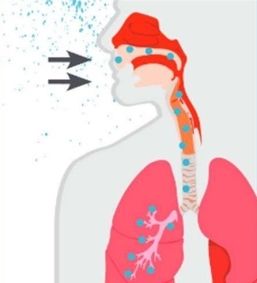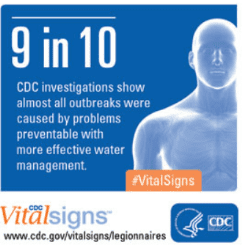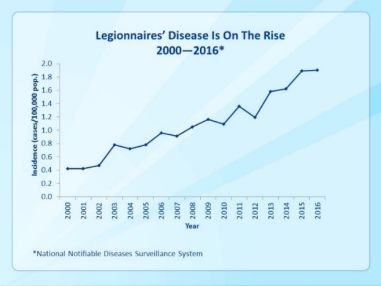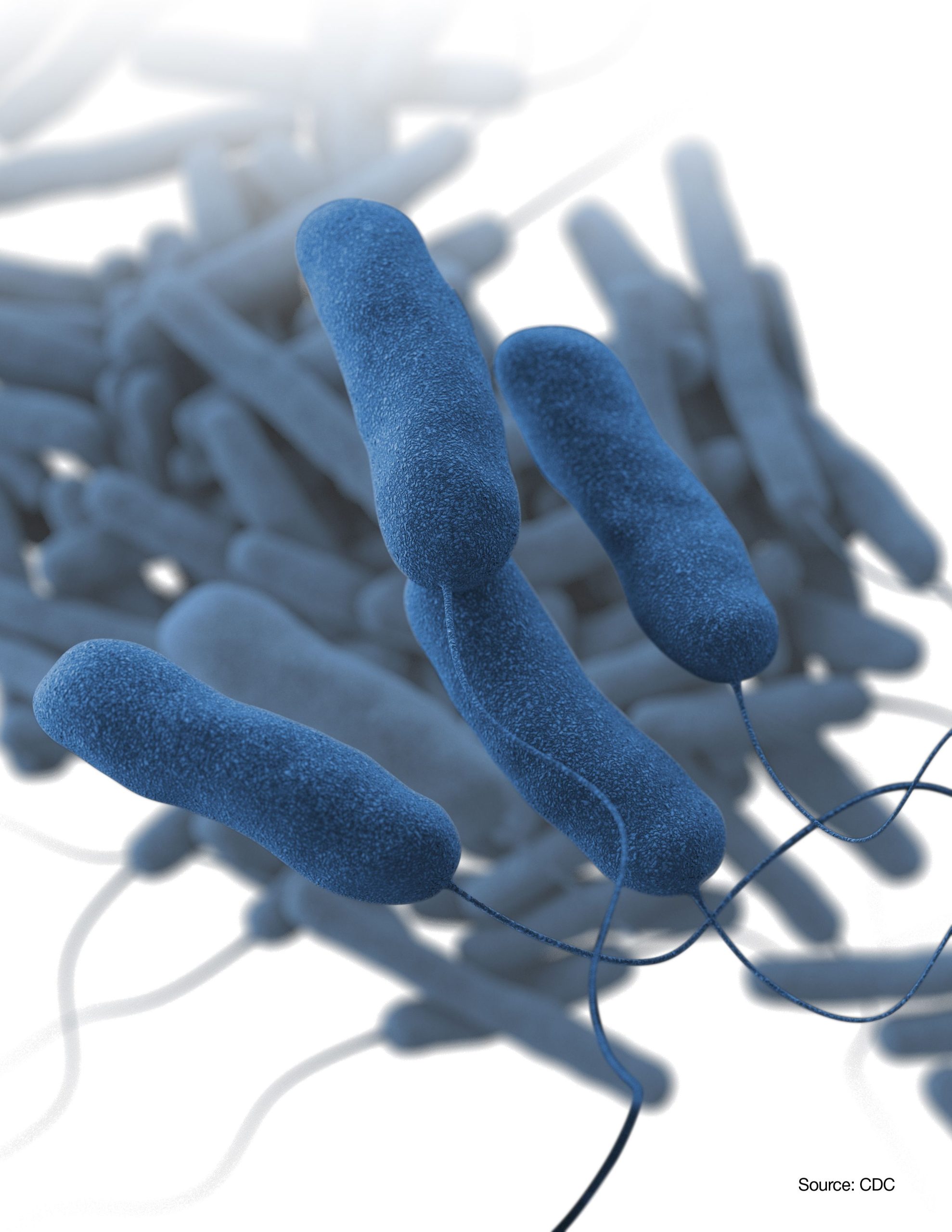Managing and maintaining your water supply properly is the most effective method in preventing Legionnaires disease in the home as well as other buildings. Regular inspection, cleaning, and disinfection of water systems help prevent Legionella bacteria from growing and multiplying. In this blog, you will learn about important things regarding Legionnaires’ disease including its causes, symptoms, and how you can minimize your risk of a Legionella infection at home. This will also serve as a guide for building owners in developing effective water management programs to prevent Legionnaires’ disease.

RPF Environmental‘s certified professionals offer Legionella assessments, water testing, and other environmental testing and consulting services in New England. We serve clients in Maine, Massachusetts, New Hampshire, and beyond the United States. Contact us now!
Things to Know About Legionnaires’ Disease
What is Legionnaires’ Disease?
Legionellosis includes two types of illnesses: Legionnaires’ disease, which results in lung infection (pneumonia), and Pontiac fever, which results in flu-like symptoms. Both are caused by different bacteria species in the Legionella family.
Legionnaires’ disease was first identified in 1976 during a convention of the American Legion in Philadelphia. Pontiac fever, first reported in Pontiac, Michigan, is a big deal too for those who contract it and for the medical centers who are burdened by an outbreak.
About ninety-eight percent of legionellosis cases result in Legionnaires’ disease; it can be deadly, and the severity of symptoms is worse than Pontiac fever, which is why there is more focus on Legionnaires’ disease.
Where is Legionella Bacteria Found?
Legionella bacteria occur naturally in freshwater and only become a problem when they are amplified in man-made water systems that are not properly maintained. These man-made water sources include the following:
- Faucets
- Showers
- Hoses
- Fountains
- Jets in hot tubs
- Whirpool spas
- Cooling towers
- Water filters
- Water heaters
- Hot water tanks
- Large Plumbing systems
- Drinking water sources
- Anywhere aerosolization occurs in an infected water system
Legionella grows best in warm water that is not moving or that does not have enough disinfectant, and it is associated with biofilms (groups of bacteria and other microorganisms). Other factors causing Legionella to grow in your household water include:
- Sinks or showers that are not frequently used
- Too low water heater temperatures
- Dirt buildup in your heater
- Not maintaining your devices properly
In addition, car and home air-conditioning units don’t use water and thus are not prone to Legionella growth according to CDC.
NOTE: Legionella can also grow in the windshield washer fluid reservoir tank of vehicles. It is recommended to only use genuine windshield cleaners.
How Does Legionnaires’ Disease Spread?
Legionnaires’ disease is contracted when a patient gets Legionella bacteria in their lungs by breathing in tiny droplets of contaminated water; it does not spread from person to person. Exposure to the droplets can occur from splashing around poorly maintained man-made water sources listed above. In addition, devices such as hydrotherapy equipment, respiratory machines, bronchoscopes, and CPAP machines offer ways in which Legionella can be spread.
Who is Most At Risk of Contracting Legionnaires’ Disease?
People that are most susceptible to Legionnaires’ disease are:
- Aged more than 50 years
- Current or former smokers
- Those with lung diseases like emphysema or COPD
- Those who have a weakened immune system from disease or medicines
- People with chronic health conditions like kidney failure, cancer, or diabetes
Moreover, healthcare facilities, including long-term care, and their patients have conditions that cause elevated risk. In 2017, the CDC noted that people got Legionnaires’ disease from a healthcare facility in 76% of the locations that reported exposures and that 25% of those died as a result.
What Are the Symptoms of Legionnaires’ Disease?

Symptoms associated with Legionnaires’ disease include:
-
Coughing
-
Shortness of breath
-
Muscular aches
-
Fever
-
Headache
Other common symptoms include diarrhea and nausea. Symptoms usually manifest within two weeks after exposure. If you are experiencing these symptoms, contact your physician immediately.
How is Legionnaires’ Disease Treated?
Most patients recover fully with treatment using antibiotics, although hospitalization is usually required. About one in ten patients die. Unfortunately, there are currently no vaccines for Legionnaires’ disease.
Legionnaires’ Disease Outbreaks Tied to Ineffective Water System Management

Most Legionella outbreaks occur in buildings that have large water systems such as hot tubs, cold/hot water tanks and heaters, large plumbing systems, cooling towers (structures that contain water and a fan as part of air-cooling systems), and decorative water systems (e.g. fountains).
CDC investigations have shown that 9 out of 10 Legionnaires’ disease outbreaks were caused by problems that were preventable with more effective water management systems. Often, there was human error (e.g. someone didn’t replace a filter as recommended by the manufacturer), there were equipment failures (e.g. a disinfection system didn’t work), or factors external to the building changed the water quality (e.g. nearby construction).
How to Prevent Legionnaires Disease: Developing a Comprehensive Water Management Program to Stop Legionnaires Disease
Preventing Legionella bacteria from growing and spreading through effective water management programs is the only way to avoid contracting the disease.
The best bet for helping to prevent Legionnaires’ disease in your building is to learn about and follow ASHRAE’s Standard 188. It is detailed, and it will take more than one read-through to absorb it. You can access it online for free and/or buy a copy on www.ashrae.org/standards, if you go to the preview section.
The CDC’s toolkit based on ASHRAE’s Standard 188, called “Developing a Water Management Program to Reduce Legionella Growth & Spread in Buildings”, contains pointers on how to implement the program.
Standard 188: How Building Owners & Managers Can Help Prevent Legionellosis
The American Society of Heating, Refrigerating and Air-Conditioning Engineers (ASHRAE) formed a team in 2005 to devise a standard for managing risk associated with building water systems. After five drafts were released for public review, the final standard was issued in June 2015, and was called Standard 188-2018, Legionellosis: Risk Management for Building Water Systems.
Standard 188 is voluntary unless it is adopted by a government entity. For example, in 2015, New York City legislated building owners to follow part of Standard 188 after there was a Legionella outbreak that resulted in the death of 12 people.
The standard addresses the risk management of Legionella in building water systems with the creation and ongoing use of a water management plan. It applies throughout the construction, operation, and maintenance phases of new building construction, renovations, modifications, or additions.
Designers and building owners and their managers are the audiences and specific building types are targeted. These include non-residential, human-occupied buildings only if there are multiple housing units with one or more centralized water systems, more than ten stories, facilities with immunologically compromised patients that stay more than 24 hours, or facilities that house people more than 65 years of age.
All potable water systems, hot or cold, are included because of their delivery mechanisms—ice machines are included. It also applies to non-potable water systems that have cooling towers or evaporative condensers, humidifiers, air washers, atomizers, misters, or any devices that result in water aerosols.
Legionella Disease Prevention Tips: General High-Level Steps of Standard 188 are as follows:
-
Establish a water management program team to develop and implement a water management program according to the standard.
-
Describe the potable and non-potable water systems and provide schematics.
-
Analyze the water systems to identify where Legionella may grow and spread.
-
Decide what control measures are needed to stay within defined control limits, where in the system they need to be, and how to monitor them. Note that there is no safe level of Legionella defined.
-
Establish what interventions are necessary when control limits are not met.
-
Make sure the program is effective and running as designed.
-
Establish documentation and communication procedures.
Monitoring your water system is an important step:
-
Monitor what is happening outside of your building. construction, water main breaks, and changes in municipal water quality can affect what is happening in your water system, including disinfectant levels.
-
Keep cold water cold and hot water hot. Water temperature fluctuations can lead to Legionella growth, and it grows best between 95°F and 115°F. Follow anti-scald regulations and consider engineering controls to mix hot and cold water near the delivery mechanism.
-
Keep an eye on changes in water pressure. The flow of water is important; stagnation can be a contributing factor in biofilm growth where Legionella can prosper. It can also reduce water temperature and overall levels of disinfectant.
-
Monitor disinfectant levels. Levels can become low through heating, storing, and filtering water. As well, outside factors such as a water main break can allow for unexpected depletion of disinfectants. Your building may need long-term supplemental disinfectants added.
Moreover, the American Industrial Hygiene Association (AIHA) issued a guideline in 2015, called Recognition, Evaluation, and Control of Legionella in Building Water Systems. It recommends proactively and routinely monitoring your water system by sampling for Legionella. Not only will it reduce the risk of the bacteria’s growth and transmission, it will help you find out if your water management program is working as intended.
There are specific methods for selecting locations and sampling methods, instructions for handling the materials, personal safety precautions to take, and considerations for interpretation of results. Let an expert handle this for you.
More Tips for Homeowners to Avoid Legionnaires Disease
Below are a few other simple tips for homeowners on how to avoid Legionnaire’s disease:
- Set your hot water tank temperature between 120°F and 140°F (this is the best Legionella prevention temperature)
- Run showers or faucets that you did not use for more than one week for at least three minutes
- Regularly fix and maintain pipes that are rarely used (dead legs) or better keep your pipework short
- Shut off and drain garden hoses that you are not using
- Clean/replace your faucet screens and shower heads everytime you see visible buildup
- Follow your manufacturer’s instructions when replacing or cleaning water filters and draining water heaters
- Individuals who are at risk of developing Legionnaires’ disease should avoid power washing and other high-risk activities that generate aerosols
Other Important Things to Know About How to Protect Yourself From Legionnaires Disease
CDC Guidance for Legionnaires’ Disease Prevention in Health Care Facilities
The risk of Legionnaires’ disease outbreaks at healthcare facilities is so high that the Centers for Medicare & Medicaid Services issued a memo in June of 2017 requiring certified healthcare facilities to have a water management program to reduce the growth and spread of Legionella. They referenced ASHRAE’s Standard 188 as a guide.
The CDC encourages healthcare facility leaders to use CDC’s toolkit as a guide for developing their water management plan (which is based on ASHRAE’s Standard 188) to:
- Work with healthcare providers to identify Legionnaires’ disease cases early
- Report Legionnaires’ disease cases to local public health authorities quickly
- Investigate and prevent additional infections
The bonus here is that this will help control other water-related, healthcare-associated infections.
There is a normative annex in the ASHRAE’s Standard 188 for healthcare facilities that meet certain qualifications. It calls for a water management program team member to be certified in infection prevention or to be an epidemiologist with a minimum of a master’s degree. It has other specifications such as criteria for the water system flow diagram, minimum requirements for the risk management plan, and types of building water systems to be included.
Legionnaires Disease Statistics
In 2018, the Centers for Diseases Control and Prevention (CDC) reported nearly 10,000 cases of Legionnaires’ disease in the United States and cautioned that it is likely underdiagnosed. The reported number of Legionnaires’ disease cases grew four-and-a-half times between 2000 and 2016—it’s not clear if this is due to increased awareness and testing, increased Legionella in the environment, aging pipes in water systems, a larger population of susceptible people, or a combination of these factors.
What is clear is that reported Legionnaires’ disease is on the rise.

Also Read:
- Top 5 Causes of a Musty Attic Smell & How to Get Rid of Them
- Mold Infestation Signs: What Does Mold in the House Smell Like
- Tips to Avoid Legionnaires’ Disease
FAQs
The best way to prevent Legionella in your home is to manage and maintain your water supply system properly to stop Legionella bacteria from growing and multiplying. Keeping your pipework short, running rarely used faucets or showers for a few minutes, and following manufacturer instructions in cleaning water heaters and filters are among the prevention tips you can follow.
“Home and car air-conditioning units do not use water to cool the air, so they are not a risk for Legionella growth.” – CDC
Legionella Pneumophila needs water to breed. Thus, the risk of getting Legionnaires’ disease through your air conditioning system is only minimal.
“The most common places where people get sick are hotels, long-term care facilities, and hospitals.” – American Lung Association
Legionnaires’ disease is less common in private homes because home water systems are not as complex as those in commercial buildings. Water in households is also used more often which prevents stagnation. You are more likely to get Legionnaires’ disease in hotels, offices, and hospitals.
Legionella bacteria thrive in temperatures ranging between 77°F to 113°F (25°C to 45°C). Thus, it’s either you keep your water storage cold or hot. Also, disinfect and clean shower heads regularly to avoid clogging and causing stagnant water to prevent Legionella growth.
Contact an Environmental Consultant for Legionella Testing
Hopefully, the next time you see an outbreak of Legionnaires’ disease in the news, you will be feeling confident that you have taken responsibility for preventing it in your own building. Be sure to look us up at RPF Environmental; we have over 25 years of testing experience and of helping customers develop environmental health and safety plans for many hazards, including Legionella. We offer baseline, proactive, and outbreak Legionella testing as well as assistance with developing building water system management plans. This includes environmental assessments to determine where Legionella may grow and spread and recommendations for baseline and proactive testing.
RPF Environmental can offer you both an outstanding team and reliable, cost-effective testing results. But what really sets us apart from the competition is our service. We believe that each project deserves the same amount of attention and focus as though it were our only one and we will find the unique, best-fit solution to your needs. We will analyze your situation from multiple angles and determine the best way to handle your Legionnaires’ disease prevention needs through our professional Legionella assessments.




